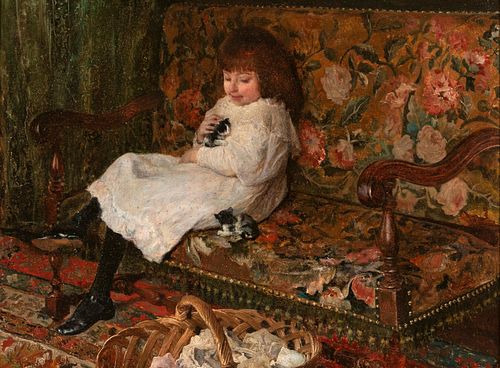JOSE JIMENEZ ARANDA (Seville, 1837 - 1903). "Girl with kittens". Oil on board.
Lot 109
About Seller
Setdart Auction House
Carrer Aragó 346
Barcelona
Spain
Setdart Subastas was born in 2004 and is currently the first online art auction in Spain with solidity, prestige and reliability guaranteed by our more than 60,000 users. Setdart has a young, dynamic and enterprising team ready to successfully manage the purchase and sale of art works through custom...Read more
Estimate:
EUR€6,000 - EUR€7,000
$6,451.61 - $7,526.88
Absentee vs Live bid
Two ways to bid:
- Leave a max absentee bid and the platform will bid on your behalf up to your maximum bid during the live auction.
- Bid live during the auction and your bids will be submitted real-time to the auctioneer.
Bid Increments
| Price | Bid Increment |
|---|---|
| EUR€0 | EUR€10 |
| EUR€200 | EUR€25 |
| EUR€500 | EUR€50 |
| EUR€1,000 | EUR€100 |
| EUR€3,000 | EUR€200 |
| EUR€5,000 | EUR€500 |
| EUR€10,000 | EUR€1,000 |
| EUR€20,000 | EUR€2,000 |
| EUR€50,000 | EUR€5,000 |
About Auction
By Setdart Auction House
Nov 10, 2021
Set Reminder
2021-11-10 08:00:00
2021-11-10 08:00:00
America/New_York
Bidsquare
Bidsquare : 19th & 20th Century paintings and Decorative Arts
https://www.bidsquare.com/auctions/setdart-auction-house/19th-20th-century-paintings-and-decorative-arts-7800
Setdart Auction House sofia@setdart.com
Setdart Auction House sofia@setdart.com
- Lot Description
JOSE JIMENEZ ARANDA (Seville, 1837 - 1903). "Girl with kittens". Oil on board. Presents label on the back. Signed in the left inferior zone. Measurements: 33 x 43,5 cm; 59 x 68 cm (frame). The child theme was a recurrent resource in the painting of the author, who liked these portraits because they allowed him to capture the spontaneity and naturalness of his models. It is true that it was not a recurrent theme in his painting, although there is an example in the Prado Museum in Madrid "The little naturalists" made in 1983. Nor is it frequent in his painting, the representation of an interior, as he liked leafy exteriors. However, this work stands out for its delicacy, which not only comes from the childish innocence but also from the sumptuous living room. A space that is defined through different fabrics and prints all defined to perfection. José Jiménez Aranda, brother of Luis and Manuel Jiménez Aranda, was a Spanish painter and illustrator who began his training with Manuel Cabral and Eduardo Cano de la Peña. His talent for drawing helped him to enter the Royal Academy of Fine Arts Santa Isabel de HungrÃa in Seville in 1851. In 1868 he was in Madrid, where he learned in the Prado Museum of the best masters, feeling special predilection for Goya and Velázquez. In 1867 he was in Jerez de la Frontera working as a restorer and designer of stained glass and, four years later, he managed to go to Rome, where he met Mariano Fortuny. He returned four years later. Between 1881 and 1890 he lived in Paris, making a series of works among which stand out those set in the eighteenth century, with great influence of Fortuny, by the success that brought him. When he returned to Madrid, he dedicated himself to a work with daily themes, but with a more costumbrist air. In 1892 he returned to Seville, where he worked as a professor at the Academy of Fine Arts until his death, teaching in turn to prominent figures such as Eugenio Hermoso, Manuel González Santos, etc., and frequenting the so-called "landscape circle of Alcalá de Guadaira" towards the end of the 19th century. Although his best known work are the scenes inspired by the art of the seventeenth century, he also dealt with religious themes and landscapes. His work received numerous awards during his lifetime (Honorary Mention at the National Fine Arts Exhibitions of 1864 and 1866; First Medal at the 1890, Medal of Honor at the International Exhibition in Munich in 1883...), and is preserved in important private collections and institutions such as the Carmen Thyssen Museum in Malaga, the Museum of Fine Arts in Seville, the Prado Museum in Madrid, etc.
- Shipping Info
-
In-house shipping available. Please inquire at admin@setdart.com.
-
- Buyer's Premium



 EUR
EUR CAD
CAD AUD
AUD GBP
GBP MXN
MXN HKD
HKD CNY
CNY MYR
MYR SEK
SEK SGD
SGD CHF
CHF THB
THB















